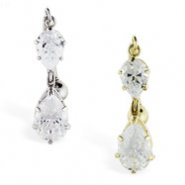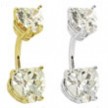14K Gold Brilliant Double Pear Reversed Navel Ring
- Length: 7/16" (11mm)
- Gauge (Thickness): 14 (1.6mm)
- Ball size: 5/32" (4mm)
- Type: belly button ring
- -: priced and sold individually
- -: Made In USA
- -: Customization available, contact us.
- Gem Type: CZ
- Gem Size: 5mm
- Gem 2 Size: 5mm
- Threading Type: Externally Threaded
- Gem Setting: Prong Set
- Gem Creation: Synthetic
- Gem Shape: Pear
- Gem Color: Clear
top teardrop gem: 6mm long bottom teardrop gem: 8mm long
| Click on the picture to see a big picture and description of the body jewelry you are interested in. | |||||||||
|---|---|---|---|---|---|---|---|---|---|
|
14K Gold reversed belly ring with...
$130.00
14K Gold reversed belly ring with double Blue Zircon teardrop dangle
|
14K Gold Belly Ring with Bottom...
$175.00
14K Gold Belly Ring with Bottom And Top Heart Czs Gorgeous
|
14K Yellow Gold Enameled Ladybug Pendant
$64.99
14K Yellow Gold Enameled Ladybug Pendant
|
14K Gold L-shaped nose pin with...
$24.99
14K Gold L-shaped nose pin with Round Amethyst
|
||||||
WHAT TO LOOK FOR IN A PIERCER
The best way to judge a piercer is to look at his/her work. If possible, talk to customers about their experiences. If this is not possible, ask to see a portfolio, specifically photographs of the piercing you are interested in and preferably photos of successfully healed piercings.
While attendance of a piercer training seminar or class should be considered advantageous, it does not guarantee a piercer's level of skill or experience. Ideally, a training seminar serves as a well-rounded introduction to safe and responsible piercing.
Consider first visiting the studio without intending to get pierced, so that you are not under pressure or too nervous to be aware of the quality of the services.
The facility should be clean, orderly, and well-lit. All Instruments utilized during the procedure should be sterile. Disposable items such as gloves, needle, cork, towels, cotton swabs, and gauze pads should all be new and sterilized if possible.
The piercer should answer any questions fully before and after the piercing is performed. You should feel comfortable and at ease, not rushed. The piercer should review the procedure and aftercare (both oral and written instructions) before performing the piercing. S/he should also discuss the risks and possible complications associated with the piercing, which may include migration or rejection, scarring, allergy or sensitivity to the jewelry or aftercare products, and a recommended course of action. The piercer should also review causes and symptoms of infection.
It is your responsibility to inform the piercer of any medical conditions which may be exacerbated by the piercing procedure or of conditions which may interfere with the healing process. A responsible piercing studio will require that you complete a waiver form which describes the limits of piercer liability as well as what you should expect before, during and after the piercing procedure. The waiver serves to protect both the piercer and customer.
In the United States most piercers require that you be 18 or over. If you are under 18 some piercers may perform some piercings with parental consent and/or presence during the piercing. Most piercers will refuse to perform certain piercings because of their location or expected further development.
Every instrument which comes into contact with your body or with the jewelry should come from sealed sterilization packets with autoclave indicators. The needle and jewelry should remain in sterilization packets or disinfectant solution until they are to be used. Jewelry, as it is received from the manufacturer, should be assumed to be non-sterile. There is some debate over whether jewelry should be sterilized in individual autoclave packages or bulk sterilized and soaked in a Level 1 hospital disinfectant (such as Madacide) prior to insertion. Ideally, the jewelry should be sterilized in individual autoclave bags and the package opened in front of the piercee so that there is no question that the jewelry has been sterilized. If the jewelry is bulk sterilized, it must be stored and handled responsibly. If the jewelry has been handled with bare hands or sitting in a display case it should be resterilized. Jewelry that has previously been worn should be sterilized.
Cross contamination occurs when a clean or sterile item comes into contact with a contaminated item. Cross contamination also occurs when a clean or sterile item is handled with contaminated gloves or gloves that have been worn to handle contaminated items. To prevent cross contamination of sterile instruments during the piercing procedure, the piercer should change gloves if s/he touches anything that is non-sterile or unsuitably contaminated (ie. handled with bare hands or used instruments that have not been sterilized). After the piercer completes the piercing procedure, s/he should change gloves before handling items that will not be disposed of or autoclaved.




